Forces and couples generated by various elements: As
we solve engineering problems, we come across many
different elements that are used in engineering structures.
We discuss some of them below focusing our attention
on what kind of forces and torques do they give rise
to.
The simplest element is a string
that can apply a tension. However a string can only
pull by the tension generated in it but not push.
For example, a string holding a weight W will
develop a tension T = W in
it so that the net force on the weight is a tension T pulling
the weight up and weight W pulling it down.
Thus if the weight is in equilibrium, T = W .
This is shown in figure 4.
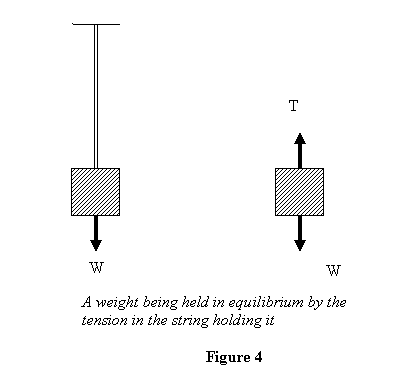
The second kind of force that is applied when two
elements come in contact is that applied by a surface.
A smooth surface always applies a force normal to
itself. The forces on a rod and on a box applied
by the surface are shown in figure 5. Thus as far
as the equilibrium is concerned, for an object on
a smooth surface, the surface is equivalent to a
force normal to it.

Imagine what would have happened
had the force by the surface not been normal. Then
an object put on a surface would start moving along
the surface because of the component of the force
along the surface. By the same argument if there
is a smooth surface near an edge, the force on the
surface due to the edge (and by Newton's IIIrd law
the force on the edge due to the surface) will be
normal to the surface. See figure 6.
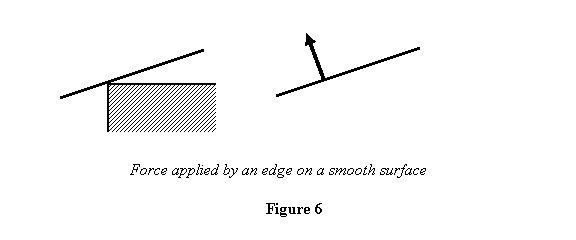
On the other hand if the surface is not smooth, it
is then capable of applying a force along the surface
also. This force is due to friction.
Let us now solve the well known example
of a roller of radius r being pulled over
a step as shown in figure 7. The height of the step
is h.
What is minimum force F required if the roller is
pulled in the direction shown and is about to roll
over the step. What are the normal and frictional
forces at that instant?
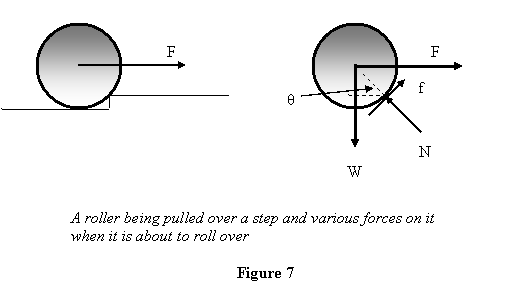
When the roller is about to roll
over the step, there will be no normal reaction from
the lower surface and therefore the roller will be
under equilibrium under the influence of its weight W,
the applied force F and the normal reaction N and
the frictional force f applied by the edge
of the step. To calculate the force F,
we apply the torque equation about the edge to get

To find N and f we apply the force
equation

That can be written in the component form a

Let us look at these equations.
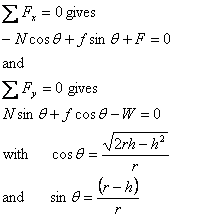
Solving these equations gives

So in this situation, we do not require friction to
keep the roller in equilibrium. On the other hand
recall the problem in the previous lecture when we
were trying to lift a 1000Nt weights by putting a
rod on a brick edge. In that case we did require
friction.
Next we consider a hinge about when an object can
rotate freely. A hinge can apply a force in any direction.
Thus it can apply (figure 8a) any force in X-direction
and any amount of force in Y-direction but no couple.

To see an example, imagine lifting a train berth by
pulling it horizontally. We wish to know at what
angle θ from the horizontal will the berth come to
equilibrium if we pull it out by a horizontal force F and
what are the forces apply by the hinges (figure 8b).
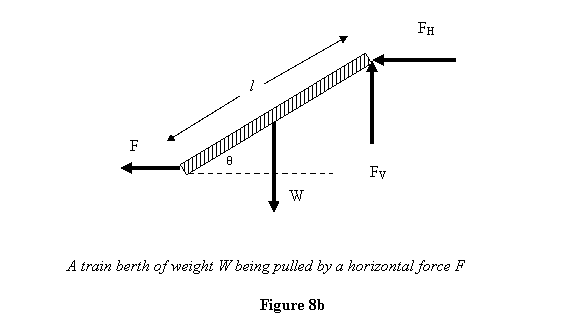
Let the weight of the berth be W and
its width l. Let the forces applied by
the hinges be FH in the horizontal
direction and FV in the vertical
direction. By equilibrium conditions


where the negative sign for FH implies
that it is in the direction opposite to that assumed.
Similarly

To find the angle we apply the moment or torque balance
equation about the hinges. Weight W gives a counter
clockwise torque of  and
the force F gives a clockwise torque of Fl sin?
and
the force F gives a clockwise torque of Fl sin?

I should point put that if the hinge is not freely
moving (for example due to friction) then it can
produce a moment (couple) that will oppose any tendency
to rotate and will have to be taken into account
while considering the torque balance equation.
Next we look at a built in or fixed support as shown
in the figure.
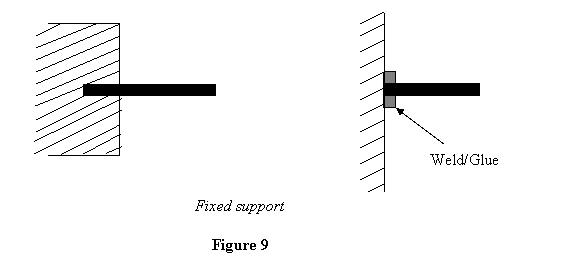
Let us analyze what happens in these cases when a
load is applied. Let us look at the built-in support.
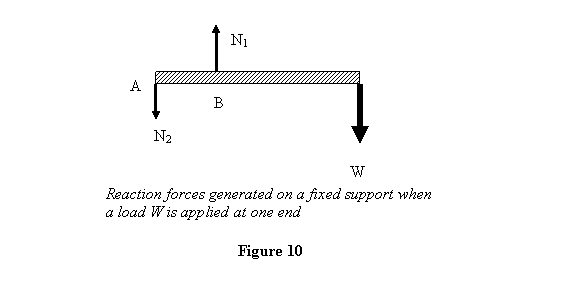
As the load is put on, the beam will
tend to move down on the right side pushing the inner
side up. This will generate reaction forces as shown
schematically in figure 10. The generated forces
can be replaced by a couple and a net force either
about point A or B as follows (see figure 11). Add
zero force N1 -N1 at
point A then the original N1 and -N1 give
a couple and no force and there is a net force ( N1 -N2) at A.

We could instead have added a zero
force N2 - N2 at
B and then would have obtained an equivalent system
with a different couple moment than the previous
case and a net force (N1 - N2)
at B. I leave this for you to see. You may be wondering
by now at which exactly does the force really act
and what is the value of the couple. Actually in
the present case the two unequal forces act on the
beam so the torque provided by them is not independent
of the point about which it is take. In such cases,
as we will learn in the later lectures, the force
effectively acts at the centroid of the force and
the couple moment is equal to the torque evaluated
about the centroid. In any case we can say that a
built-in support provides a couple and a force. We
give the schematic picture above only to motivate
how the forces and the couple are generated.
In reality the forces are going to be distributed
over the entire portion of the support that is
inside the wall and it is this distribution of
force that provides a net force at the centroid
and a couple equal to the torque calculated about
the centroid, as we will see in later lectures.
Note that deeper the support is fixed into a
wall, larger would be the couple provided by
it. Hence whereas to hang a light photo-frame
or a painting on a wall a small nail would suffice,
a longer nail would be better if the frame is
heavy. In addition to providing a force perpendicular
to the support and a couple, a fixed support
also provides a force in the direction parallel
to itself. Thus if you try to pull out the support
or try to push it in, it does not move easily.
The forces and couple provided by a fixed support
are therefore as shown in figure 12.

Let us now look at the support welded/ glued to the
well. In that case suppose we put a load W at
the end of the beam, you will see that the forces
generated will be as shown below in figure 13.

where in this particular case the horizontal forces
must be equal so as to satisfy

Thus the horizontal forces provide a couple and the
beam can be said to provide a couple a force in the
direction perpendicular to the support. Further a
glued support also cannot be pulled out or pushed
in. Therefore it too is capable of providing a horizontal
nonzero reaction force. Thus a welded or glued support
can also be represented as shown in figure 12. Note
that wider the support, larger moment it is capable
of providing. Let us now solve an example of this.
Example: You must
have seen gates being supported on two supports (see
figure 14). Suppose the weight of the gate is W and
its width b. The supports are protruding
out of the wall by a and the distance between
them is h. If the weight of the gate is
supported fully by the lower support, find the horizontal
forces, vertical forces and the moment load on both
the supports.
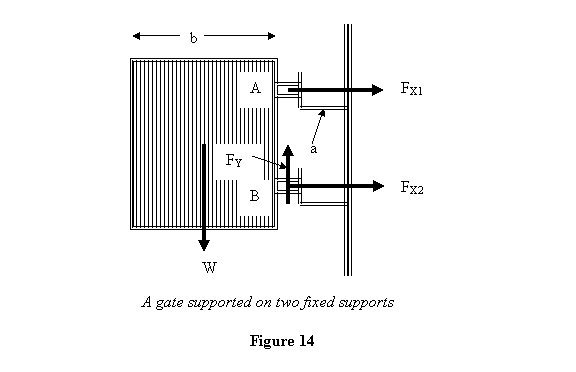
To solve this problem, let us first find out what
are the forces required to keep the gate in balance.
The forces applied by the supports on the gate are
shown in figure 14. Since the weight of the gate
is fully supported on the lower support all the vertical
force is going to be provided by the lower support
only. Thus

Similarly

To find,  ,
let us take moment about point A or B
,
let us take moment about point A or B
Let us make  .
This gives (following the convention that counterclockwise
torque is positive and clockwise torque is negative)
.
This gives (following the convention that counterclockwise
torque is positive and clockwise torque is negative)
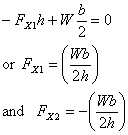
The negative sign for FX2 means
that the force's direction is opposite to what it
was taken to be in figure 14. We also wish to find
the forces and couple on the support. By Newton 's
IIIrd Law, forces on the support are opposite to
those on the gate. Thus the forces on the two supports
are:
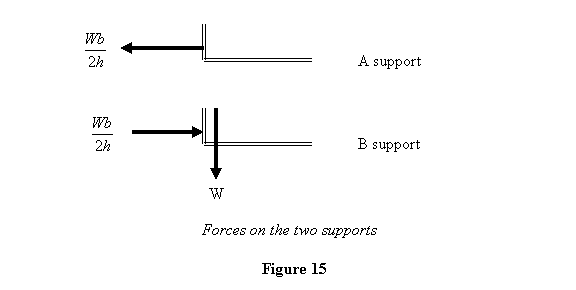
You see that support A is being pulled out whereas
support B is being pushed in (we observe an effect
of this at our houses all the time: the upper hinges
holding a door tend to come out of the doorjamb).
Now the force by the wall on support A will be  to
the right to keep it fixed in its place. On the other
hand the situation for the lower support is more
involved. The lower support will be kept in its place
by the wall providing it horizontal and vertical
forces and a torque. The net horizontal force is
to
the right to keep it fixed in its place. On the other
hand the situation for the lower support is more
involved. The lower support will be kept in its place
by the wall providing it horizontal and vertical
forces and a torque. The net horizontal force is  to
the left and the net vertical force is W pointing
up. The lower support also balances a torque. Taking
the torques about the point where it enters the wall,
its value comes out to be
to
the left and the net vertical force is W pointing
up. The lower support also balances a torque. Taking
the torques about the point where it enters the wall,
its value comes out to be

If we assume that the net vertical force and the torque
is provided by only two reaction forces at two points
as in figure 10, these two reaction forces can be
calculated easily if we know the length of the portion
inside the wall. I leave it as an exercise. In solving
this, you will notice that the reaction forces are
smaller if the support is deeper inside the wall.
As pointed out earlier, in reality the force is going
to be distributed over the entire portion of the
support inside the wall. So a more realistic calculation
is a little more involved.
To summarize this lecture, we have
looked at some simple engineering elements and have
outlined what kind of forces and torques are they
capable of applying. In the next lecture we are going
discuss forces in three dimensions. We are also going
to look at conditions that forces with certain geometric
relations should satisfy for providing equilibrium.